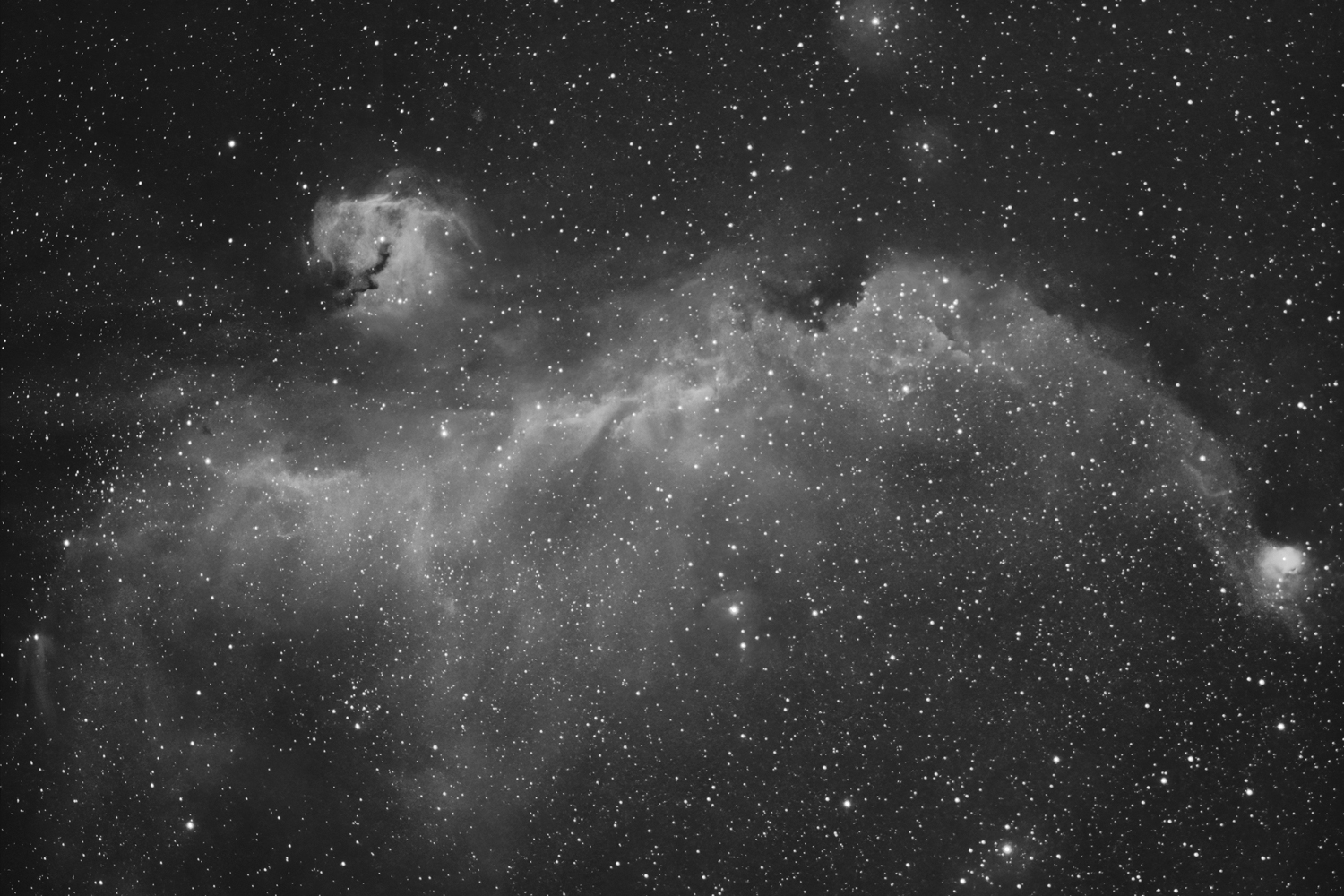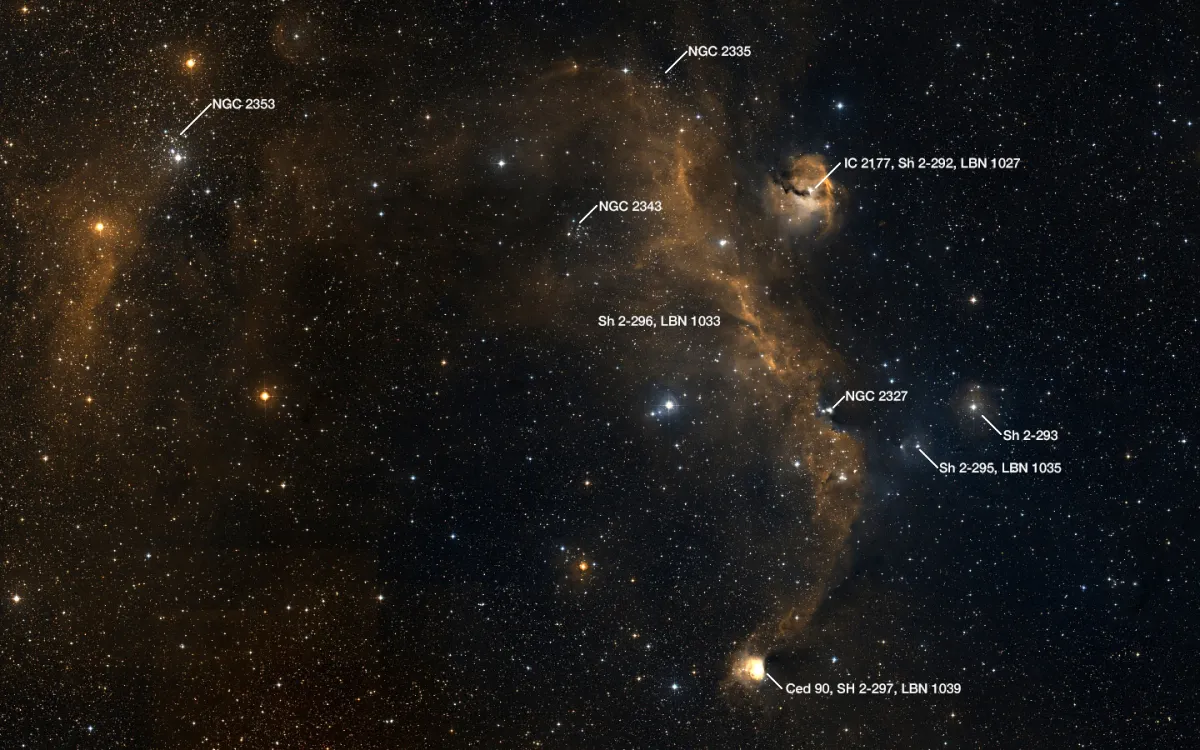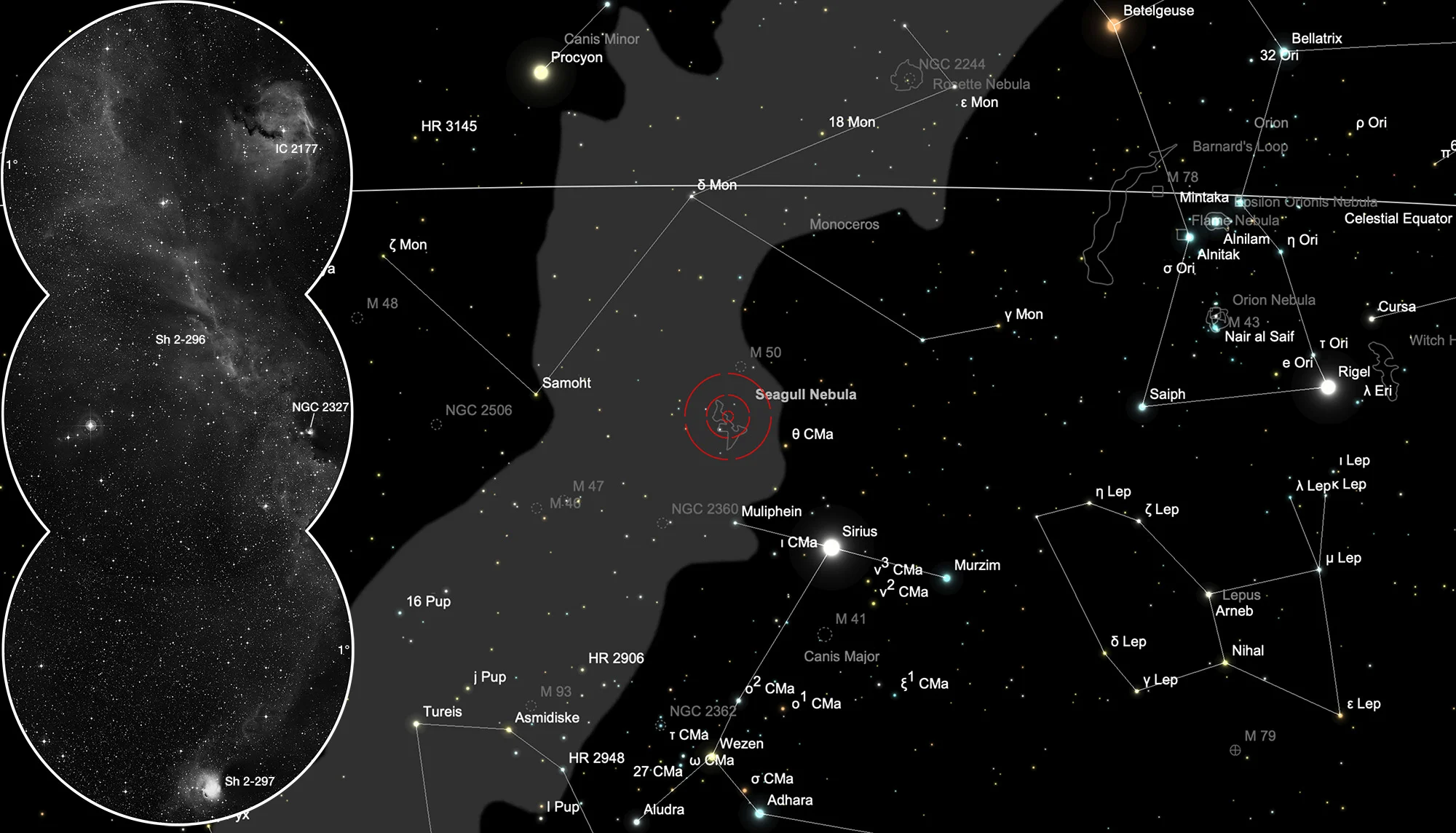Seagull Nebula (IC 2177)



History
On 10 January 1785 William Herschel sweeped his 18.7 inch reflecting telescope through the constellation Monoceros and found three «coarsely scattered clusters of stars»: VIII 32 (NGC 2335), VIII 33 (NGC 2343) and VIII 34 (NGC 2353).
Few nights later on 31 January 1785 William Herschel came again across the same region and found an object, which he classified as IV 25 (class IV = planetary nebulae, stars with burs, with milky chevelure, with short rays, remarkable shapes, etc). He noted: «A pcst. (pretty cometic? star) with very faint and very small much chevelure of an irregular figure.» [463] His Sohn John cataloged that object in 1833 as h 428, not being sure whether it was the same as IV 25. He described it with: «A double star whose large star is in centre of a very faint nebula which involves the small star also.» [466] In his «General Catalogue» the object got the designation GC 1487 and the description: «pretty bright double star involved in small, very faint nebula.» [467] In 1888 Dreyer added this discovery as NGC 2327 to his «New General Catalogue». [313]
In 1898 the British astronomer Isaac Roberts took a picture of that region using the 20" reflector at his observatory «Starfield» in Crowborough Hill, Sussex, UK. He wrote: «Nebula in Monoceros in which the star 7.3 mag BD -10°1848 is involved together with several other faint stars. The nebula is irregularly round, bright, with a wide nebulous band across it in s. f. to n. p. direction. The nebula is about 13 minutes of arc in diameter.» [554] This sighting was then added as IC 2177 by Dreyer in 1910 to his «Second Index Catalogue». [315]
In 1955 Colin S. Gum from the Commonwealth Observatory in Canberra did a survey of H-II regions and identified parts of the nebula, which are known as Gum 1, Gum 2 and Gum 3. [555] Stewart Sharpless «Catalogue of H II Regions» published in 1959 lists Sh 2-292, Sh 2-295, Sh 2-296, Sh 2-297. [310] In the early 1960ies Beverly Lynds identified numerous dark (LDN 1657, LDN 1658) and bright nebulae (LBN 1027, LBN 1033, LBN 1035, LBN 1039) in this region. [270, 473]

Physical Properties
This is an interstellar cloud of dust, molecules, hydrogen, helium and other ionised gases where new stars are being born. The whole nebula is also known under the designation Canis Majoris OB1 association (CMa OB1).
The main components of the Seagull are three large clouds of gas, the most distinctive being Sharpless 2-296, which forms the «wings». IC 2177 or SH 2-292 forms the «head of the seagull». The hydrogen glows brightly red due to the energetic radiation from embedded very hot young star HD 53367 (BD -10°1848) and becomes a HII region. HD 53367 is a Be type star with 20 times the mass of our Sun. It has a companion with 5 solar masses in a highly elliptical orbit. Light from the hot blue-white stars is also scattered off the tiny dust particles in the nebula to create a contrasting blue haze.
Dark lanes of dust interrupt the glowing clouds. These are parts of much denser material that hide some of the luminous gas behind them. Nebulae like this one have densities of a few hundred atoms per cubic centimetre, compared to the density of the surrounding nebula of about 1 atom per cubic centimetre.
The entire nebula is located about 3700 light-years away from earth and spans over 100 light-years across. [556, 557, 558]
| Name | RA | Dec | Type | vMag | Dim | MD | Dreyer Description | Identification, Remarks |
|---|---|---|---|---|---|---|---|---|
| NGC 2327 | 07 04 07.2 | -11 18 51 | RN | 1 × 1 | 1.200 | pB ** inv in S, vF, neb | WH IV 25; h 428; GC 1487; CED 89B | |
| NGC 2335 | 07 06 49.4 | -10 01 43 | OCL (III3m) | 7.2 | 7 | 1.417 | Cl, L, lC | WH VIII 32; GC 1494; OCL 562 |
| NGC 2343 | 07 08 06.7 | -10 37 00 | OCL (III3p) | 6.7 | 6 | 1.056 | Cl, cL, P, lC | WH VIII 33; GC 1498; OCL 565 |
| NGC 2353 | 07 14 30.3 | -10 15 57 | OCL (II2p) | 7.1 | 18 | 1.119 | Cl, L, lC, one vB * | WH VIII 34; GC 1506; OCL 567 |
| IC 2177 | 07 04 25.3 | -10 27 13 | EN | 20 × 20 | 1.120 | pB, eL, iR, v dif | LBN 1027; vdB 93; Sh2-292; Be star |
Finder Chart
The nebula IC 2177 is located between the constellations Monoceros and Canis Maior. The best season for observation is from October until March.
Visual Observation
762 mm Aperture: The nebular part IC 2177 represents only the head of the whole Gull Nebula. The eye is a pair of double stars in a rather circular nebular part. This pair of stars also serves as starting point for the black line-shaped dark nebula, which arcs towards the star line starting above, which ends at two stars standing at right angles to the line. — 30" SlipStream-Dobson f/3.3, Hasliberg, 14. 2. 2023, Eduard von Bergen
